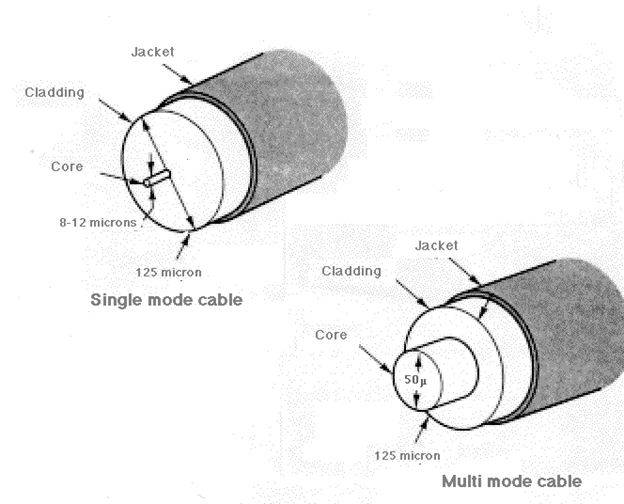Types Of Fibers:multimode Optical Fibres
Types of fibers:Multimode optical fibres:
A 50/125 μm multimode graded index optical fibre cable:
The characteristics of a multimode graded index optical fibre cable were specified in Recommendation ITU-T G.651, originally published in 1984 and deleted in 2008. Recommendation ITU-T G.651 covered the geometrical and transmissive properties of multimode fibres having a 50 μm nominal core diameter and a125 μm nominal cladding diameter.
That Recommendation was developed during the infancy of optical fibre solutions for publicly switched networks. At that time (pre-1984), these multimode fibres were considered as the only practical solution for transmission distances in the tens of kilometres and bit rates of up to 40 Mbit/s. Single-mode fibres, which became available shortly after the publication of ITU-T G.651, have almost completely replaced multimode fibres in the publicly switched networks.
Today, multimode fibres continue to be widely used in premises cabling applications such as Ethernet in lengths from 300 to 2 000 m, depending on bit rate. With a change in the applications, the multimode fibre definitions, requirements, and measurements evolved away from the original ITU-T G.651 and were moved to the modern ITU equivalent, Recommendation ITU-T G.651.1.
Recommendation ITU-T G.651.1, Characteristics of a 50/125 μm multimode graded index optical fibre cable for the optical access network, provides specifications for a 50/125 μm multimode graded index optical fibre cable suitable to be used in the 850 nm region or in the 1 300 nm region or alternatively may be used in both wavelength regions simultaneously. This Recommendation contains the recommended values for both the fibre and cable attributes.
The applications of this fibre are in specific environments of the optical access network. These environments are multi-tenant building sub-networks in which broadband services have to be delivered to individual apartments. This multimode fibre supports the cost-effective use of 1 Gbit/s Ethernet systems over link
lengths up to 550 m, usually based upon the use of 850 nm transceivers. Quite a large percentage of all customers in the world are living in these buildings. Due to the high connection density and the short distribution cable lengths, cost-effective high capacity optical networks can be designed and installed by making use of 50/125 μm graded-index multimode fibres.
The effective use of this network type has been shown by its extended and experienced use for datacom systems in enterprise buildings with system bit-rates ranging from 10 Mbit/s up to 10 Gbit/s. This use is supported by a large series of IEEE system standards and IEC fibre and cable standards, which are used as the main references in Recommendation ITU-T G.651.1.
